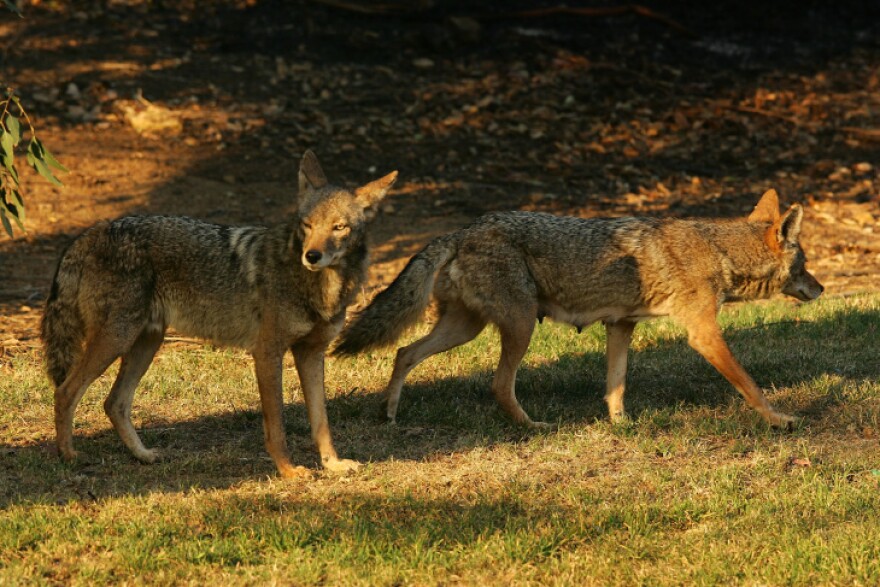This story is free to read because readers choose to support LAist. If you find value in independent local reporting, make a donation to power our newsroom today.
Coyotes Seem More Aggressive? That’s Because They’re Feeding Their Pups. Here’s What You Need To Know

If you feel like there’s been more coyotes around your neighborhood, acting more aggressively, you may be right.
Coyotes have wrapped up their infamous mating season — and now it’s time to cue the cute factor: Coyote pup season is in full swing. And that means some behavioral changes.
What you should know about the season
Coyotes have three biological seasons, said Niamh Quinn, a human-wildlife interactions advisor with the University of California’s Department of Agriculture and Natural Resources.
There’s breeding season, pup season, and then what she calls the dispersal season, where the young coyotes go off on their own. But during pup season, the coyotes are focused on raising and caring for the babies.
“They're starting to den down, and it’s been shown in certain areas that coyotes can be very aggressive around the den itself at that time,” Quinn said.
In California, coyotes breed primarily between January and March, according to the U.S. Forest Service. Their litters, which can be about five to six pups each, are born between March and May. Some packs may start earlier in the year, she said. For example, her team saw dens being dug out as early as December in Orange County.
But what most coyotes are doing now is beginning to raise those babies. That typically lasts until September.
During this time, the adult coyotes have more mouths to feed.
Understanding coyote behavior
Coyotes are cooperative breeders, meaning that the pack gets involved to help raise the young. That creates a lot of activity around the dens.
“The thing about a coyote den is that you could be stood right on top of one and not even know it's there,” Quinn said. “Like they're quite small openings.”
All a coyote needs is to be able to go in, turn around and come back out. They’re often found in the open spaces around us, like nature reserves, nurseries, railway lines and on Southern California Edison’s easement land.
But they can show up around parks and even under homes. So while you may not see ones for months, they are almost always nearby in L.A. County. While these animals aren’t strictly nocturnal, they’re most active between dusk and dawn.
HOW TO REPORT COYOTE ISSUES
If you’re in the city of L.A., report problems to L.A. Animal Services.
For the county (and those in unincorporated L.A.), report issues through the county's online form or by calling 626-575-5462.
Coyote behavior does change in L.A. County’s pup season, Quinn said, but not always. Members of the pack leave the den, but data is mixed on whether it’s a true increase in activity compared to other seasons.
“I would say that probably in L.A., you get a lot of encounters during the pup rearing season,” Quinn said. “Then you probably get like a small peak as well during dispersal when the juveniles are starting to move on.”
While many Southern Californians get rightfully concerned about seeing coyotes — they can and do attack animals and people — others feel we need to learn to co-exist.
Tujunga resident Jason Holmes grew up in the country, which he says gave him a perspective on nature that he’s trying to pass on to his very young daughter.
“We grew up around coyotes, mountain lions … I just think it's really important that people get out in nature. We have a lot of fear where fear doesn’t have to necessarily be,” Holmes said. “[But] now that I have a child, yeah, they’re more of my concern.”
Meanwhile Jerome Agee says the different seasons of their life cycle reminds him of how close L.A. is to the wild. He sees coyotes as just like any other animal.
“We're in their neighborhood. This is their home,” Agee said. “So we got to learn how to get along. Cause you know, they got the right to survive just like we.”

Ways to stay safe
There are steps you can take to keep you, your small children and your animals safe.
Coyote encounters can just be a sighting, or an animal or human attack. But it’s less common for coyotes to bite humans — usually they go after small animals, like cats and dogs.
“If you don't want your cat eaten by a coyote, you don’t let your cat outside,” Quinn said.
Dogs are a little different because they can be attacked on leashes too. It’s a smart idea to minimize the length of your leash, and of course, don’t take your dog off the leash in public.
If you do encounter a coyote, one option is to scare them off with a loud noise. Some well-used dog walking areas have home-made shakers on hand, like this one in East Pasadena.

You can learn more in our guide to living safely with our coyote neighbors.
See where coyotes are near you
If you’re curious where coyotes have been reported near you, check out locations below, updated with the University of California’s Coyote Cacher data as of April 24.
A few caveats to keep in mind: Reports don’t represent the total amount of coyote sightings this year. The service relies on people submitting individual reports, which can only be done in English.
People can always elect to report coyotes to other places, like a county service, or not report them at all. So an empty spot on the map does not necessarily mean there are no coyotes near you.











